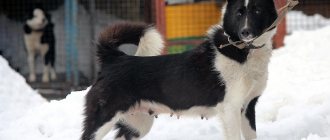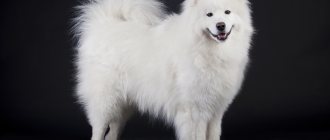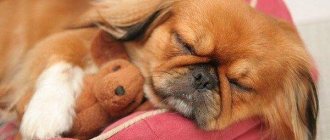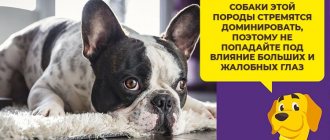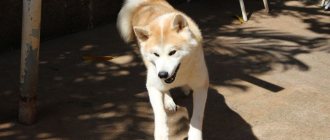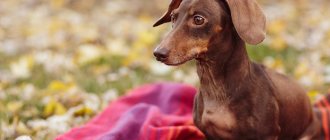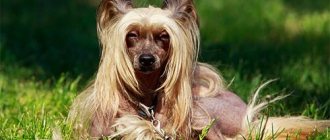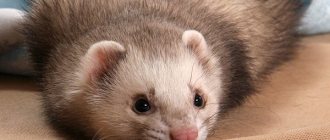Photos of newborn puppies
Puppies are born slightly deaf and completely blind. Their ears and tail can still be pressed to the body. The claws are small and not yet strong, there are no teeth.
NOTE!
The color of the puppies does not necessarily match the coat color of the parents, so if you see differences, this does not mean that the litter is not purebred.
Their fur is already curly and you can see curls on it. Babies may crawl to reach their mother and her milk.
Poodles' eyes open two weeks after birth, but sometimes earlier. If you notice that this does not happen, then you should show the baby to the veterinarian.
The size and weight of puppies of this breed depends on a number of factors:
- Number of puppies in the litter;
- Condition of the mother during pregnancy;
- Genetic disposition;
- What was the mating for the bitch?
On average, a puppy weighs 500-700 grams at birth, and its size is about 20-23 cm.
Development by months
How does a poodle puppy develop from 1 to 12 months:
| Puppy age | Description | Size | Weight |
| 1 month | The puppy is just learning to navigate in space. At this time he is strongly attached to his mother and brothers. It is not yet possible to transfer it to a new home. This should have been done earlier, but now we have to wait. It's time to start weaning the puppy little by little from its mother. | About 15 cm | 1.2 kg |
| 2 months | Now is the time when it is easiest for a baby to get used to something. It's time to hand it over to its new owners. It’s also time to start accustoming him to a collar, brush, leash and start training him. This is also the time to start toilet training. | 17-20 cm | 2.5 kg |
| 3 months | "Age of Fear" By this time, you should already be walking the puppy, because if you start late, it will be difficult to cope with him shaking from every bush. | 23.5 cm | 2.9 kg |
| 4 months | At this age, your pet begins to become attached to you. Play with him more and spend time with him, but don't let him do too much. | 27 cm | 3 kg |
| 5 months | The dog should now go to the toilet only outside. A period of complete environmental research begins. Allow your dog to do this, but watch what he does. | 28 cm | 3.5 kg |
| 6 months | Beginning of puberty. From this time on, other dogs stop looking at your pet as if it were a puppy. Start training if you have completed the educational part. | 29 cm | 4 kg |
| 7 months | Puberty continues, and the dog also learns to communicate with other animals in new ways. Learn how to react correctly to dog conflicts. | 30 cm | 4.3 kg |
| 8 months | The dog begins to understand its place in the pack-family. She acutely feels guilty for her misdeeds and unquestioningly obeys the slightest commands from her owner. | 30.4 cm | 4.5 kg |
| 9 months | You continue to be involved in the world around you and are aware of your role in the home. | 31 cm | 5 kg |
| 10 months | The dog is getting more and more mature. Puberty continues. | 31.5 cm | 5.4 kg |
| 11 months | The dog is approaching a year old and its maturation is gradually coming to an end. By this age, the pet should already know most of the commands, as well as distinguish between “good and bad”. | 32 cm | 5.8 kg |
| 12 months | Your dog is now an adult. It will not undergo any more dramatic changes for several more years. | 33 cm | 6 kg |
Poodle puppies grow up to a year inclusive, and their growth gradually slows down as they approach 12 months of age. To know which month the growth corresponds to, it is necessary to take measurements and compare them with the standard .
IMPORTANT!
If you see that your dog is lagging behind in development, then take him to the veterinarian. It may be lacking some nutrients or vitamins.
Basic care rules
In order for your puppy to grow up healthy and happy, you need to care for him by following some rules:
- In the first days, be extremely attentive to the puppy and be affectionate with him. It was hard for him to move to a new house; he misses his mother and brothers. You must show him that you do not pose any danger, but on the contrary.
- If there are children in your house, then it is worth explaining to them that the animal is not a toy. You should not disturb him while he sleeps or pull his paws or ears. Show how to properly handle your new pet.
- The pet must have its own place to sleep and rest. Don't disturb him if he settles on it to catch his breath.
- The dog should have its own toys. As he grows up, he will have a need to chew on something and play with something. It would be better if it were his things than yours.
- Make sure that there are no things valuable to you or anything small that are dangerous for him on the floor or in the dog’s access area.
- Start teaching him his name and hygiene procedures: trimming his nails, cleaning his ears, rubbing his eyes, and checking his teeth. He must get used to the fact that such things will be repeated regularly.
- When walking outside, do not let your puppy pick up any objects from the ground, especially not eat or chew them. Do not let your dog off the leash unless you are sure that it is accustomed to you and will not rush after the first car or cyclist.
- The puppy should always have clean water freely available.
- Do not forget how many times a day you need to feed the puppy, and also that gradually the number of meals should be increased to twice a day.
Stages of brushing a poodle
The dog is placed on a grooming table or any other surface; the main thing is to ensure the convenience and safety of the procedure. Before grooming, care for the ears and nails.
Using a slicker, first check how painful the pressure is on your own hand in order to understand with what force to comb the hair.
Poodle owners prefer to comb the coat in layers, starting from the body in the area above the elbow, in a horizontal line along the entire side. Make a parting, comb the hair from root to tip below the parting in the direction of growth, then move to the hair above the parting against growth.
After the slicker, they go through the comb, identifying tangled areas and only after making sure that there are none, move on to the next layer, making a new parting a couple of centimeters higher than the previous one, gradually approaching the back and neck.
On a note! The tangles are untangled with your fingers using a metal comb or slicker. Slightly tangled hair can be easily separated with your fingers. Tight tangles will have to be sorted out using combs, but you should start from the ends. First use a slicker brush, then a comb.
A good quality shampoo and conditioner helps prevent hair from becoming tangled. It is recommended to apply a conditioner solution from a spray bottle before the procedure so that the hair is not injured and does not accumulate static electricity. The hair is slightly moisturized, the moisture evaporates quickly, but the hair is not dry.
Upon completion, the side of the body is treated with a massage brush. Then move on to the neck and stomach. Next, comb the front leg, layer by layer, starting from the bottom on the side, moving to the front side, then the side again, and only lastly moving to the inside. After the front leg is processed, move on to the hind limb. The hind limb begins to be combed from the hip, moving downwards. Having dealt with one side, the wool is processed in the same way on the other side. They are careful and spend more time on problem areas, namely the armpits, behind the ears, elbows, knees, hocks, where the hair often and sometimes strongly rolls up.
Then the dog is put on its feet, and they begin to lay the fur along the spine, starting from the neck to the tip of the tail. There is no need to pull the tail. Lastly, attention is paid to the hair on the head, ears, and front of the chest.
They begin to comb the head from the back of the head, also in layers. On the head, the hair is scratched first in the direction of growth, then against the direction of growth to give a characteristic volume. The hair on the head and face should be handled with extreme care so as not to damage the eyes.
The ears are combed, starting from the inside, carefully, carefully, gradually moving to the outside. The hair behind the ears is as thick as on the rest of the body; it often gets tangled due to the fact that dogs itch with their paws. Therefore, you need to be careful so that the process does not turn out to be painful for the dog.
The front part of the chest is easy to scratch when the dog is sitting. Start from the bottom point, working your way up in layers, similar to the process of processing wool on the side of the body.
On a note! During the styling process, you should inspect the skin for rashes, redness, the presence of ectoparasites, and dandruff. After completing the procedure, the pet is given a treat and praised for good behavior.
It is recommended to brush your pet daily to keep its coat clean and well-groomed. But not everyone has this opportunity, so you need to carry out the procedure at least once a week. In addition, be sure to comb your pet before bathing.
After water treatments, it is necessary to dry and comb the poodle's coat at the same time. You need to comb the hair against the direction of hair growth, slightly pulling it up, as if standing it down. After combing with a comb, the wool is dried with a hairdryer, keeping it in a fluffy state with a brush.
At the end of the procedure, the dog is praised and allowed to shake itself, so the hair will return to its natural position.
How to toilet train?
Toilet training a puppy should be done in several stages:
- Set up a place where your dog can go when he needs to. This can be done even before it appears.
- Remember that babies go to the toilet often. Watch and you will see that this happens after every meal. If the puppy begins to sniff the floor and spin around restlessly, then it’s time to take him to the place that you have equipped for him. If he did everything right, then praise him with a treat.
- If your pet still didn’t have time or didn’t make it, then don’t rush to punish or scold him. Remember that he is still a child and does not quite understand what they want from him.
- If you see that the dog has started doing business in the wrong place, then shout sharply to it and immediately take it to the toilet. There, if everything ends successfully, praise him.
- Once your pet has received all its vaccinations, you can train it to go to the toilet outside. Remember that puppies often have to manage things, so at first you will have to walk him 5-6 times a day. Whenever successful, praise him and give him a treat.
- First, go for walks with him at the same time so that he gets used to the walking schedule. If you see that he asks outside your walking period, then take him for a walk anyway.
- Don’t rush to remove the litter box right away, because the dog won’t be able to tolerate it for long. As he gets older, he will need to go to the toilet less often, only then his place in the house can be cleaned.
NOTE!
Toilet training is an important period in a dog's life. You need to show as much patience as possible and not go too far with punishments. It is absolutely forbidden to hit a puppy, this will have a negative impact on his psyche.
After purchasing a puppy, the owner will immediately discover that the poodle will have to be cut frequently. But if a poodle lover intends to remember this twice a year, shaving his head in desperation, this begs the question: why then buy such a difficult dog to care for? Wouldn't it be easier to take a dachshund, a French bulldog, or maybe a Mexican hairless dog?.. After all, the main decoration of a poodle, but also its problem, is its fur. A properly cut and styled dog is worthy of the admiration of others.
Of course, the owner can contact a hairdresser, but he must know that the main burden of daily combing lies with him. No hairdresser would want or be able to comb hair in a few hours that hasn’t been touched for months. A good advertisement for a master is a dog he has cut and walks with the owner on the street. Don’t be afraid to stop them and ask the owner for the hairdresser’s phone number, of course, if you liked the dog’s haircut. The second way is to contact a dog lovers club, where there are always professionals. They will not only cut the hair, but also give owners advice on care, proper washing and drying of the coat.
Of course, not every poodle that needs a haircut can go to a show tomorrow and fight there for high titles. But why should there be a difference between a show hairstyle and a hairstyle for every day? A poodle always has the right to be a poodle, and no one, neither a lazy owner nor an impostor hairdresser, can take away this right from a miracle dog that has been decorating human life for many centuries.
Anyone who undertakes to cut a poodle's hair must have, in addition to hairdressing skills, the eye of a sculptor and the taste of a fashion designer. It’s not enough to just remove everything unnecessary; you need to be able to choose for your client a hairstyle model that will not only suit him, but also highlight the best in his appearance. A poodle's hairstyle is his elegant dress, and it should fit like a glove. This work requires enormous patience and kindness - you cannot rush or be nervous, anger or offend the dog. You need to be able to understand the state of a cheerful poodle, forced to freeze for a long time in an uncomfortable position.
As practice shows, many hairdressers and poodle owners do not pay attention to recommendations for performing the preparatory part of the work, namely: combing, washing and drying the coat. If you want your hairstyle lines to retain their appearance long after a haircut, you cannot ignore any of these rules:
1. Walk the dog very well, 2. Carefully comb the coat with a comb before bathing. Remove matted tangles with your hands. But if, nevertheless, the dog is so neglected that it is impossible to cope, it is better to cut them off before washing them. 3. While bathing, cover the dog’s ear canals with cotton wool swabs soaked in Vaseline oil. 4. Use shampoo for dry hair, diluted with water, or special shampoos for dogs. 5. Rinse off the shampoo with a strong stream of lukewarm water, continuing to massage the hair and skin. Only wool that is well washed, without the slightest trace of shampoo, can be combed well, which means it can be trimmed well. 6. Wring out the wool thoroughly with your hands, then, without rubbing, blot the sheet almost dry. 7. Start blow-drying from those parts of the body where the hair is shortest. If short hair is not dried by pulling it with a comb immediately after washing, it will become very frizzy and it will be almost impossible to straighten it with a haircut.
8. It is necessary to dry and comb the coat at the same time. You need to comb against the direction of hair growth, slightly pulling it up, as if standing it up. After combing the wool with a comb, dry it with a hairdryer, keeping it in a fluffy state with a brush.
After drying, you should not take the poodle outside earlier than 3-4 hours later. You also need to make sure that the dog does not lie on one side for a long time, otherwise the hair will become wrinkled and the hairstyle will turn out to be asymmetrical.
And the most important secret: you can have a beautifully grown poodle, a subtle artistic taste, purchase the best tool or invite the most famous hairdresser, and not achieve the desired result. This will happen if, during a haircut, the poodle joyfully jumps like a wild mustang or, rolling its eyes in fear, slides off the table; if it is impossible to touch either the muzzle or the toes (without risk to your own), and it is impossible to persuade him to part with a single hair. So, the main condition for an excellent haircut and hairstyle is to educate the poodle to be patient and accustomed to all procedures.
From a very early age, the puppy should be brushed in all directions with a bristle brush. When the fur grows back, you can start combing it with a comb. The baby needs to be encouraged with kind words and praise. Gradually, daily brushing will not only become a habit, but will also become a joy for the dog - after all, this is a rare opportunity to communicate with the owner, to hear from him the words so necessary for every real poodle: “How wonderful and irresistible you are!”
At 4-5 months, the poodle should already be standing on the table with its head raised and hind legs outstretched, calmly responding to combing, clicking and touching scissors, and then to the buzzing of the machine. Wipe his face every day after eating, don’t forget to clean under his tail, and thoroughly clean his paws after a walk - this will teach your poodle to calmly handle everything that is necessary to complete the most intricate hairstyle.
Source: Tatyana Osennikova, World of Dogs magazine
What and how to feed?
At first, when the dog was just brought to you, feed him the same thing that the breeder gave him.
You cannot abruptly cut off his usual diet and replace foods with those that suit you. This will cause digestive upset in the baby, which will take a long time to treat. Such a sudden transition can generally lead to death.
What to feed the puppy in the future is up to you. Each of the feeds, whether natural or artificial, is good in its own way and has its own pros and cons.
Menu changes should occur smoothly. Just start feeding your pet the foods you plan to feed him for the rest of his life. Gradually, his body will begin to get used to it, and you will be able to give him the food you think is necessary.
The number of feedings depends on the age of the puppy:
- 1-2 months – 5-6 feedings;
- 2-3 months – 4-5 feedings:
- 3-4 months – 3-4 feedings;
- 4-6 months – 2-3 feedings;
- After 7 months – 2 feedings.
You should not give your puppy foods that are difficult to digest - fried, salty, spicy, baked and sweet. On the contrary, introduce him to fresh fruits and vegetables, such as apples or carrots.
The menu for puppies is not rich in variety, and you will have to alternate foods, because you need to feed often and little by little.
Here is a menu for a 3-4 month old puppy that you can alternate:
- 1st day . 1st feeding: 2 tbsp. low-fat cottage cheese, chicken egg, 1 tsp. natural honey, 1 tsp. low-fat organic yoghurt. Mix and give to the puppy. 2nd feeding: 2 chicken wings, vegetables (carrots, cabbage, apple, parsley), minced in a meat grinder, 1 tsp. olive oil, vitamins. 3rd feeding: 3 whole chicken necks (by this time the puppy should already be able to chew thoroughly). 4th feeding: 1 chicken wing or two necks, vegetables minced in a meat grinder (carrots, cabbage, apple, parsley), 1 tsp. olive oil, vitamins.
- 2nd day . 1st feeding: 2 tbsp. low-fat cottage cheese, chicken egg, 1 tsp. honey, 1 tsp low-fat bio-yogurt or kefir. 2nd feeding: 3-4 chicken necks or 2-3 wings, twice a week raw boneless sea fish is given instead. 3rd feeding: large parts of chicken wings, ground into a meat grinder, vegetables also chopped, some offal (liver or heart), 1 tsp. flaxseed, 1 tsp. apple cider vinegar, 1 tsp. fish oil, vitamins. 4th feeding: 3-4 chicken necks.
Common diseases and vaccinations
How long do poodles live? The lifespan of these animals is quite long: they live for about 12 years. Nevertheless, tail docking, as well as timely vaccinations, are recommendations that should be followed. For example, when a puppy is 2-3 months old, he needs to be vaccinated against distemper and rabies.
Remember: before vaccinating a miniature poodle, it is necessary to cleanse the pet’s body of worms, since their presence will weaken the immune system.
In general, the animal is in good health, but its eyes may often water. If your poodle's eyes are running excessively, he should be taken to the vet immediately.
Similar article: Description and breed standard of the Large Royal Poodle
Vaccination schedule
Puppies up to one year old will need the following vaccinations:
- 8-10 weeks is the first vaccination for a puppy against parvovirus enteritis, viral hepatitis and distemper;
- 11-13 weeks - second vaccination against parvovirus enteritis, viral hepatitis and plague. At this time, the puppy receives its first vaccination against rabies.
If the risk of contracting rabies is low, for example, the puppy does not come into contact with carriers of the virus, then vaccination can be delayed until 6-9 months.
Hygiene procedures
Puppies need to undergo the following procedures:
- You need to examine your teeth once every two weeks, trim your nails as they grow, clean your ears once a week with a damp cloth, not a cotton swab, and wipe your eyes with the same frequency.
- Give your puppy special “sticks” from the pet store to prevent tartar, or brush his teeth yourself with a special brush.
- The poodle is a breed that needs a haircut in order to look beautiful and well-groomed. If you don't know how to do this correctly, contact a groomer. Usually this procedure needs to be repeated every 1-1.5 months.
- Brush poodle puppies with a furminator once every two weeks.
- You need to bathe as you get dirty, but on average repeat this procedure once a month.
How to care for a poodle's coat
The poodle's coat has its own characteristics: it grows in bushes from one hair follicle (“sheep's wool”). During shedding, dead hair does not fall out, but becomes tangled in curls. Therefore, the dog needs to be combed 2-3 times a week with a large, wide-toothed comb and a massage brush.
It is recommended to wash the dog once every 2 months, using special shampoos. The poodle is also washed before grooming, and the mats are cut off with scissors or a mat cutter. To maintain a neat appearance, the fur on the face and paws can be trimmed with a hand-held clipper (trimmer).
If you want your pet to grow cords, brush him only when he is a puppy. When a poodle's coat changes, the puppy stops being brushed and the coat begins to curl into natural curls. The cords are simply carefully taken apart by hand so that they do not get tangled into one tangle. Corded poodles are bathed less frequently.
When is weaning from the mother?
In nature, the mother begins to wean the puppies when they are 3-4 weeks old. Breeders do this when the offspring reaches a month old.
IMPORTANT!
Weaning should not happen immediately; you cannot simply tear the dog away from its mother’s milk. Just start limiting the puppies from feeding them, for example, by taking the dog to an area where the babies cannot go. Introduce complementary foods.
Owner reviews
“When we got four-month-old Molly, a small apricot poodle, we had no idea how to cut her hair. There was an agreement with the breeder that we would bring her once every 2 weeks, at a time convenient for her, and wait until she was groomed. This was extremely inconvenient for us, since we had to constantly take time off from work.
As a result, I took matters into my own hands, and after several unsuccessful attempts I learned how to tidy up the wool quite well. Of course, I wouldn’t risk cooking like that for an exhibition; for a home haircut, such skills are more than enough.”
Larisa Ivanova, owner of the small poodle breed.
“I was recommended to wash my dog no more than once every three months, but then a disgusting dog smell appeared. Since our poodle sleeps with us and generally loves to cuddle, this schedule was unacceptable to us. We started washing it once every 3-4 weeks – the unpleasant smell disappeared!
I use human shampoos and conditioners, and every other time I make a mask with deep hydration. I’m happy with the result, the fur is shiny!”
Olga Makarova, toy poodle.
How to choose your future pet?
The choice of a poodle puppy must be careful, because everyone wants to have a real puppy, and not a mixed breed or a fake that unscrupulous breeders want to sell.
What to pay attention to:
- Examine the candidate. His coat should be shiny, curly and without any bald spots or bald spots.
- The limbs must be intact, the tail without kinks.
- Nothing should flow from the nose or ears, and there should be no unpleasant odor from the mouth.
- There should be no lameness when walking or running.
- Check your puppy's tummy to see if it is bloated or not.
- See how he eats, check his appetite.
- The dog should not show aggression or fear. A healthy puppy shows curiosity, is playful and cheerful, and is not lethargic.
- Look at the parents and how they behave, because the future behavior of the puppy largely depends on the temperament of the parents.
- If purebred is a decisive criterion for you, then ask the breeder to show all the documents for the parents, check the brands in a special database.
NOTE!
The price of a poodle puppy depends on many factors, but on average it varies from 25 to 35 thousand rubles.
